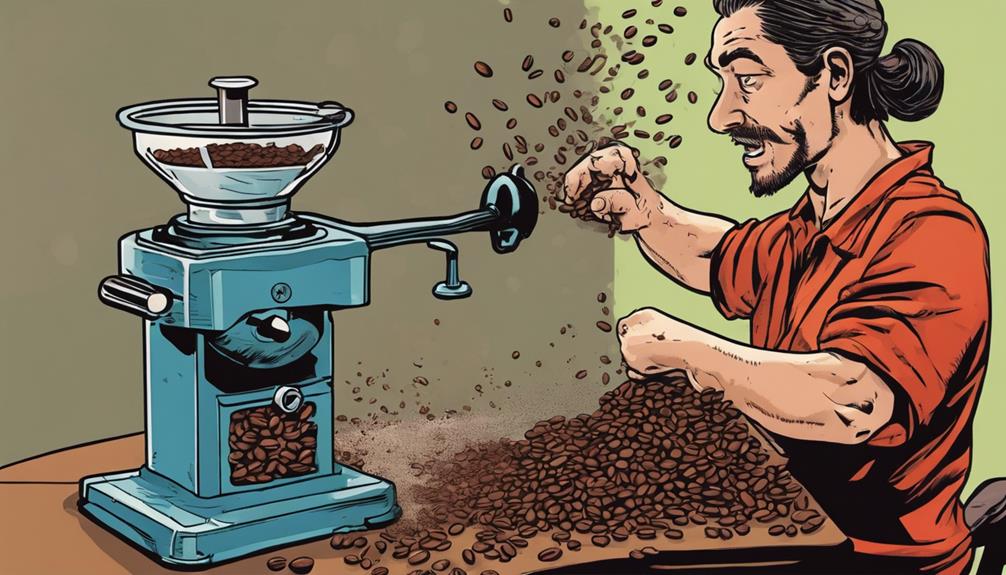Enhance your skin’s radiance by incorporating coffee into your skincare routine! Create a coffee scrub by mixing grounds with water for a silky smooth complexion. Alternatively, combine coffee with honey for a replenishing face mask. Boost circulation by infusing coffee grounds in oil or utilize brewed coffee as a toner for rejuvenation. To reduce puffiness and dark circles around the eyes, apply chilled brewed coffee. Uncover the benefits of coffee’s antioxidants, exfoliation, collagen stimulation, and more for glowing skin!
Key Takeaways
- Use coffee grounds as a scrub for exfoliation.
- Mix coffee with honey for a nourishing face mask.
- Infuse coffee grounds in oil for a glowing massage.
- Brew coffee for a revitalizing toner application.
- Apply chilled brewed coffee under eyes to reduce puffiness.
Skin Benefits of Coffee Powder
Coffee powder offers numerous skin benefits due to its rich antioxidants and exfoliating properties, helping to rejuvenate and enhance your skin's appearance. When used on your face, coffee powder acts as a natural exfoliant, gently scrubbing away dead skin cells to reveal a smoother complexion.
Its antioxidant content helps protect your skin from free radicals, reducing the risk of premature aging. The exfoliating properties of coffee powder also stimulate blood circulation, which can minimize the appearance of cellulite and reduce under-eye puffiness.
Furthermore, incorporating coffee powder into DIY face masks can provide your skin with a natural boost, leaving it glowing and revitalized. Regular use of coffee powder in face masks can improve the texture of your skin, making it look healthier and more radiant.
DIY Coffee Face Masks

Enhance your skincare routine with the rejuvenating benefits of DIY coffee face masks for a glowing complexion.
DIY coffee face masks are a fantastic way to apply the antioxidant properties of coffee to your skin, helping to reduce dark spots and promote glowing skin. These masks also have excellent exfoliating properties, removing dead skin cells and revealing a smoother, brighter complexion.
By improving blood circulation, coffee face masks can enhance your skin's overall appearance and radiance.
Additionally, DIY coffee face masks can boost skin elasticity and provide anti-inflammatory benefits, reducing puffiness and giving your skin a refreshed look. The antioxidant properties of coffee further help to protect your skin from environmental damage while promoting a healthy glow.
Incorporating these masks into your skincare routine can be a simple yet effective way to achieve a more radiant and revitalized complexion.
Coffee for Acne Treatment

To effectively address acne concerns, utilizing the antibacterial and anti-inflammatory properties of coffee can be advantageous for your skin's health and clarity. Coffee's caffeine content helps decrease inflammation and redness linked to acne breakouts, while its exfoliating properties unclog pores, preventing new acne formation.
The antibacterial characteristics of coffee combat acne-causing bacteria, promoting clearer skin. Additionally, coffee can regulate oil production, reducing the likelihood of acne flare-ups. The antioxidants in coffee also aid in skin healing and repair, assisting in the treatment of acne scars and blemishes.
Coffee for UV Protection

Coffee isn't just for waking you up in the morning; it's also a natural way to shield your skin from harmful UV rays. When you apply coffee topically, it forms a protective barrier against the sun's damaging effects.
Incorporating coffee into your skincare routine can help in preventing sun damage and maintaining healthy, glowing skin.
UV Protection Benefits
Shield your skin from harmful UV rays by harnessing the protective benefits of coffee due to its polyphenols content.
Polyphenols in coffee act as a natural shield against UV rays, helping to reduce fine lines caused by sun exposure.
The antioxidant properties of coffee play an essential role in protecting the skin from sun damage, ultimately preventing premature aging.
For enhanced UV protection, consider mixing coffee with lemon juice before applying it to your skin. This combination not only boosts the skin's defense against UV rays but also provides a invigorating and rejuvenating effect.
By incorporating coffee into your skincare routine, you can fortify your skin's defenses against the harmful effects of sun exposure, maintaining a youthful and radiant complexion in the long run.
Embrace the power of coffee to shield your skin from the sun's damaging UV rays and preserve its natural beauty. Incorporating coffee into your skincare routine can provide your skin with antioxidant protection, reducing the risk of sun damage and premature aging. Consider adding a coffee face mask routine to your weekly skincare regimen to lock in moisture and keep your skin looking radiant and youthful. The natural caffeine in coffee can also help to improve blood circulation, reducing the appearance of dark circles and puffiness around the eyes.
Coffee and Sunlight
By incorporating coffee into your skincare routine, you can effectively enhance your skin's defense against harmful UV rays. Coffee acts as a natural barrier against UV radiation, reducing fine lines and signs of sun damage.
The polyphenols in coffee provide protection from UV-induced damage by neutralizing free radicals. The antioxidants present in coffee not only help in maintaining skin health but also aid in protecting the skin from the harmful effects of UV exposure.
When applied topically, coffee can contribute to shielding your skin from UV radiation and its potential to cause damage. Including coffee in your skincare regimen can offer added protection against the sun's harmful rays, promoting healthier and more radiant skin.
Skin Protection Tips
Enhancing your skin's defense against harmful UV rays can be achieved by incorporating coffee into your skincare routine. Coffee powder offers significant benefits for skin protection, thanks to its polyphenols and antioxidants that help combat the damaging effects of UV radiation.
Creating a coffee face pack for UV protection is simple and effective. Mix a tablespoon of coffee powder with a tablespoon of lemon juice, a teaspoon of honey, and a few drops of oil. Apply the mixture to your face, gently massaging it in circular motions. Leave the pack on for about 15-20 minutes to allow the ingredients to work their magic. Rinse off with lukewarm water and pat your skin dry.
Regular use of this coffee face pack can assist in reducing sun damage, minimizing fine lines, and maintaining a healthy skin appearance. Make this skin protection tip a part of your skincare regimen for radiant and well-protected skin.
Coffee for Pigmentation

Using coffee on your skin can help reduce pigmentation and dark spots, thanks to its skin-brightening properties.
The antioxidants present in coffee can work to even out your skin tone and fade hyperpigmentation over time.
Pigmentation Reduction
To reduce pigmentation and achieve a more even skin tone, consider incorporating coffee into your skincare routine for its effective lightening properties. Coffee masks can help fade dark spots and promote a balanced complexion by reducing melanin production, thanks to the antioxidants present in coffee. The exfoliating properties of coffee aid in gently sloughing off dead skin cells, which can assist in fading pigmentation marks and unveiling brighter skin over time. Regular use of coffee on the skin can contribute to improving pigmentation issues gradually. For enhanced pigmentation-reducing effects, you can combine coffee with other natural ingredients like lemon juice or honey. These combinations can amplify the benefits of coffee and further aid in achieving glowing skin.
| Key Benefits | How It Helps | Recommended Combos |
|---|---|---|
| Lightens dark spots | Reduces melanin production with antioxidants | Coffee + Lemon Juice |
| Promotes even skin tone | Fades pigmentation marks through exfoliation | Coffee + Honey |
| Reveals brighter skin | Improves overall skin appearance over time | Coffee + Yogurt |
Brightening Effects
For a noticeably enhancement in your skin's radiance and reduction of pigmentation, incorporating coffee into your skincare routine can be highly beneficial. The antioxidants present in coffee can effectively reduce pigmentation and dark spots, leading to a brighter and more even skin tone.
The caffeine in coffee not only helps in reducing pigmentation but also promotes blood circulation, aiding in achieving a more radiant complexion. By applying coffee topically, you can target skin pigmentation, resulting in a glowing complexion.
Coffee face masks are particularly useful in addressing pigmentation issues and promoting a brighter, more even skin tone. Regular use of coffee on your face can significantly contribute to diminishing the appearance of dark spots and enhancing skin radiance.
Embrace the benefits of coffee for your skin to enjoy a more luminous and even complexion.
Coffee for Brightening Skin

Enhance your skin's radiance by harnessing the brightening properties of coffee. Coffee isn't just for perking you up in the morning; it can also perk up your skin by providing a natural glow and improving skin tone.
Here's how coffee can brighten your skin:
- Exfoliating Benefits: The coarse texture of coffee grounds can help scrub away dead skin cells, revealing a smoother and brighter complexion.
- Antioxidant Power: Coffee is packed with antioxidants that can combat free radicals, reducing dark spots and promoting a more even skin tone.
- Collagen Boost: Caffeine in coffee can stimulate collagen production, improving skin elasticity and firmness for a youthful glow.
- Glowing Skin: Regularly using a coffee paste with water or honey can help you achieve glowing skin by enhancing circulation and promoting overall skin health.
Frequently Asked Questions
How to Apply Coffee on Face for Glowing Skin?
To apply coffee on your face for glowing skin, create a mask with coffee powder and ingredients like honey or milk. Apply it on your face, avoiding your eyes, and leave it for 15-20 minutes. Rinse off for radiant skin. Another option is to mix coffee grounds with coconut oil and use it as a scrub for exfoliating your skin. This can help remove dead skin cells and promote new cell growth for a healthier complexion. Whether you choose to use a coffee face mask or a coffee scrub, incorporating coffee into your skincare routine can help improve the overall appearance and glow of your skin.
What Happens if We Apply Coffee on Face Daily?
If you apply coffee on your face daily, you may experience skin irritation, dryness, sensitivity, or allergic reactions. It's better to use coffee occasionally to maintain your skin's natural balance and avoid potential adverse effects.
What Does Putting Coffee on Your Face Do?
Putting coffee on your face can brighten and rejuvenate your skin, thanks to its antioxidant properties. It exfoliates, revealing smoother skin, improves blood circulation, reduces puffiness, soothes inflammation, diminishes dark circles, and promotes a more even skin tone.
Does Coffee Remove Dark Spots?
Can coffee remove dark spots? Yes, it can. Coffee's antioxidants and caffeine promote skin renewal and circulation, aiding in fading dark spots. Regular use, along with natural ingredients like lemon juice or honey, enhances its effectiveness over time.
Conclusion
Now that you know the amazing benefits of coffee for your skin, why not give it a try?
Just a simple DIY coffee face mask can work wonders for your complexion, leaving you with a radiant glow like a shimmering morning dew on a rose petal.
So go ahead, pamper yourself with some coffee love and watch your skin transform!









